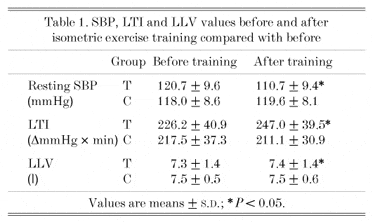During orthostasis, the cardiovascular system attempts to maintain blood pressure (BP) to avoid syncope. Low orthostatic tolerance has been noted in subjects with lower baseline BP than more tolerant subjects (Stevens, 1966). Hence resting BP may be important in determining tolerance to simulated orthostasis (LBNP). Isometric exercise training has been shown previously to reduce resting blood pressure (Wiley et al. 1992). Therefore, the purpose of this study was to investigate the effect of reduced resting blood pressure, following isometric exercise training of the legs, on LBNP tolerance.
A training group (T) (n = 9; mean ± S.D., age 21.1 ± 1.2 years; height 178.4 ± 7.5 cm; mass 78.6 ± 10.2 kg) and a control group (C) (n = 8; age 24.5 ± 6.1 years; height 177.9 ± 9.9 cm; mass 75.8 ± 7.0 kg) gave informed consent to participate in the study, which was granted ethical approval. Subjects’ LBNP tolerance and lean leg volume (LLV), using anthropometry (Jones & Pearson, 1969), were assessed before and after a 5-week period in which T completed isometric exercise training using the quadriceps femoris. HR and BP were measured during LBNP and tolerance was quantified using the LBNP tolerance index (LTI). Changes in resting systolic BP (SBP) before training, after training and immediately before the second LBNP test were analysed using a one-way repeated measures ANOVA, and if significant (e.g. P < 0.05), confidence intervals were calculated using the Bonferroni test. Before and after training comparisons in time to peak HR, LTI and LLV were made using t tests. A P value of less than 0.05 was considered to show a significant difference.
Following the exercise training period, resting SBP was reduced and LLV increased in T (P < 0.05; Table 1). Tolerance to LBNP also improved in T (P < 0.05; Table 1), and there was a delay in the time to peak HR during LBNP (1462.4 ± 257.2 vs. 1582.2 ± 257.8 s; P < 0.05).
These results suggest a possible association between reduced resting SBP and improved LBNP tolerance. However, the increase in LLV should also be considered as it may have affected vascular compliance (Convertino et al. 1988), which has been known to influence LBNP tolerance (Luft et al. 1976). Support for this notion was provided by the delay in the time to peak HR during LBNP. Thus the changes in LLV may have masked the effect of reduced resting BP on LBNP tolerance. It should also be noted that SBP was no longer reduced immediately before the LBNP test after exercise training (P > 0.05). The association between reduced SBP and LBNP tolerance remains unclear.

